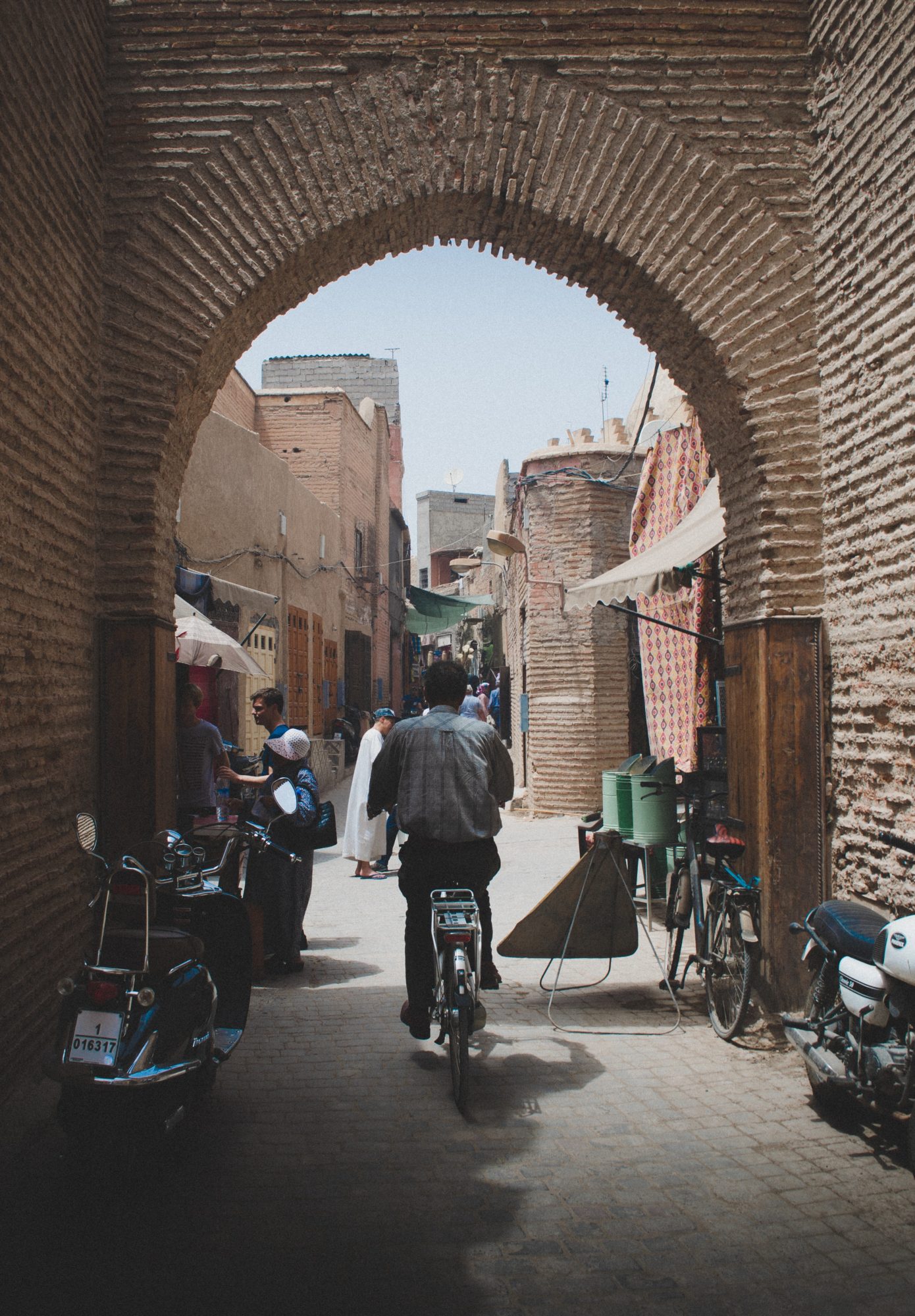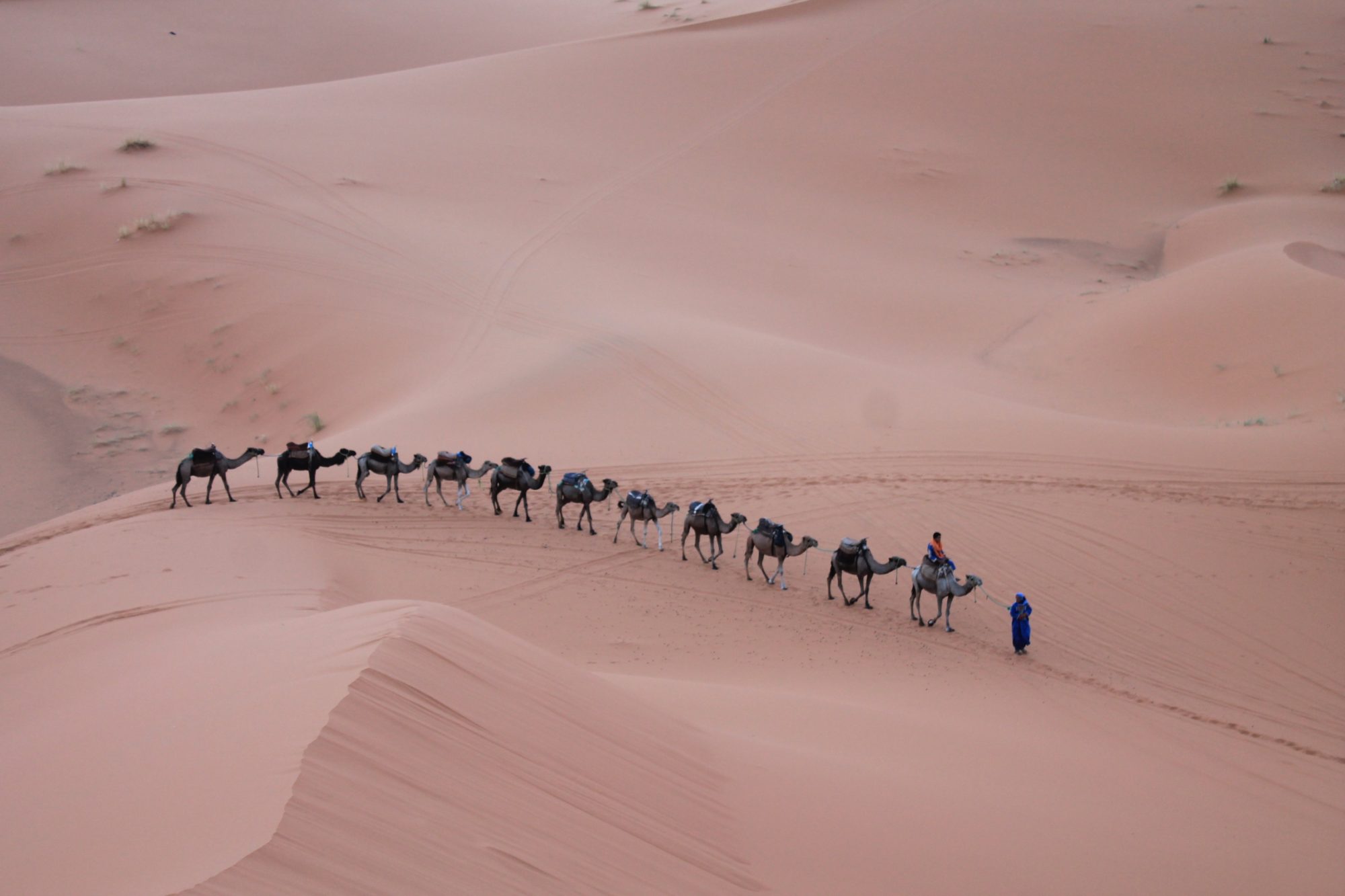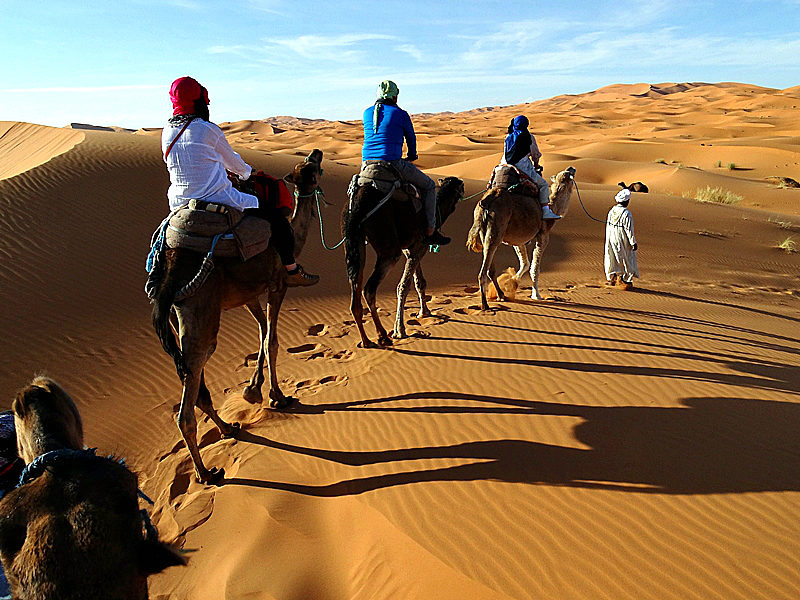Morocco is a diverse country, featuring a unique blend of Arabic, Berber, and French culture. The sights that stand along the Atlantic Coast have a strong imprint of the European colonists, whereas the Berber culture dominates the inland and spans from the desert regions to the impressive range of the Atlas Mountains. Morocco offers a thrilling array of delights, from the snow-capped high peaks and the Sahara’s golden sand dunes to luxurious riads tucked into hidden dead-end streets of medinas and authentic Berber traditions. Let’s see a short list of some awesome, top sights in Morocco that you should definitely visit.
1. The Four Imperial Cities

The historical capitals of Morocco—Fes, Marrakesh, Meknes, and Rabat, feature the most famous medinas, the local term that designates the old part of a town. Medinas have a maze of narrow winding streets where one can find everything, from mules carrying heavy gas tanks to elegant riads with elaborately decorated courtyards. You will stumble upon public fountains with colorful zellij (mosaic), religious complexes with mosques, shrines, and madrassas (Koranic schools) as well as local hammams (public baths) and souqs (markets) selling pottery, jewelry, Berber carpets, and herbal remedies.
The largest medina in the world, Fes-el-Bali, is a 9th-century labyrinth of 9000 lanes and alleyways, listed as UNESCO World Heritage Site and certainly one of the top sights in Morocco. The medina of Marrakesh is dominated by the animated Djemaa el-Fna Square, a public place where something happens at any time of the day—from snake charmers to women making henna tattoos and vendors selling fresh orange juice. A one-hour drive from Fes, Meknes is less visited, but its Imperial City features immense granaries and stables, once home to 12,000 horses. From all the historic capitals of the country, Rabat is presently the current capital and calls attention to lush Andalusian gardens, a perfectly preserved kasbah (mud-brick fortress), and the Roman ruins with the Merenid necropolis of the Chellah.
2. The Desert Sand Dunes


Morocco features two desert regions with golden, scenic sand dunes: Merzouga and Zagora-M’Hamid. While Merzouga is easily accessible for a day trip with camels in the desert, Zagora-M’Hamid spans over a larger desert region and requires a multi-day trip if you want to explore its wilderness. You can tailor any tour in the desert according to your needs, from jeep tours that require a shorter amount of time to camel treks that last longer and offer a unique, authentic experience. Plan a bit in advance for your desert tour as there are a few things that you should know before going into the Sahara Desert.
3. The Atlas Mountains

The High Atlas Mountains run across Morocco for almost 1000km and Mount Toubkal (4167 meters altitude) is the most climbed mountain in the country. The highest peak in North Africa and the Arab World, Jebel Toubkal is called the “rooftop of North Africa.” However, climbing Toubkal is a demanding and technical ascent so, unless you have a good physical condition, there are countless multi-day treks at the foot of the mountains. Imlil small town (1740m) is the main trekking base for summiting Jebel Toubkal but also for other easier treks exploring Berber traditional villages.
When I went to the High Atlas Mountains, I was able to hike along the Ait Mizane Valley only half of the way to Toubkal. I stopped at Marabout Sidi Chamharouch (2310m)—a shrine where Muslim pilgrims hike to pray—but I gave up the ascent because of the cold (10°C / 50°F at noon, in late May). From my own experience, don’t underestimate the temperatures in Morocco, especially when you plan an ascent to higher elevations.
4. The Argan Oil Cooperatives
View this post on Instagram
In South-Western Morocco is the paradise of the Argan tree, which is unique to this part of the world and one of the top sights in Morocco. Argan oil has been a mainstay for the local Berbers but has gained a reputation worldwide after being designated by UNESCO in 1999. Nowadays, the organic Argan oil is the world’s most expensive edible oil (approximately $300 USD per liter). It takes 30 kilograms of Argan nuts and 15 hours of manual labor to produce one liter of oil.
If you see goats climbing into the branches of a tree between Essaouira and Marrakesh, you will know it’s an Argan tree. Stop there and explore one of the numerous Argan oil cooperatives in the Souss Valley. The Argan oil is harvested only by women’s cooperatives and you will have the chance to witness the whole process of production there. Also, don’t forget to try the tasty amlou, a hearty mix of Argan oil, ground almonds, and honey.
5. The Mosque of King Hassan II, Casablanca

One of the top sights in Morocco, Casablanca is the most cosmopolitan city in Morocco, where modern French architecture meets the local Moroccan traditions. Built on a rocky outcrop from the Atlantic Ocean, the enormous Mosque of King Hassan II was completed in 1993. In fact, it is a vast religious complex, with a mosque, rooms for ablutions, hammam, Islamic center, and library. The world’s third largest mosque can accommodate 25,000 worshipers and has the tallest minaret in the world (210 meters high).
This is the only mosque in Morocco open to non-Muslim visitors. You cannot enter the mosque on your own and once you are there, you will have to wait for the next guided tour (every two hours). I was one of those lucky persons who had the chance to visit the big mosque right at the moment when the retractable roof was opened. The guide was explaining to us the modern technologies used to build the mosque, and at that moment, the roof started to move and we could see the sky. It doesn’t happen all the time but if you visit it on Friday, you might be lucky.
6. Chefchaouen




Perched beneath the Rif Mountains, Chefchaouen (or the Blue City) was once the hidden gem of Northern Morocco. However, it has become so famous for its blue-washed houses lining the winding narrow lanes that you cannot say you have been to Morocco without seeing Chefchaouen. The name of the town actually means “Look at the Peaks.” Wandering the old medina, you’ll experience a unique blend of Moroccan and Andalusian influence, possibly meet the “Berber car” (the mules), and—to give you a heads up—may even be asked if you want to try marijuana. Half-an-hour walk from the medina, the fascinating Spanish Mosque sits in an outstanding location on one of the surrounding hills. Not only does it have an intriguing history, but it’s also the preferred lookout point for locals. From there one can see the whole medina, the Ras el-Maa waterfalls, and the mysterious nearby Rif mountains.
7. The Kasbahs of the Draa Valley
View this post on Instagram
Built along the former caravan routes from Mali to Marrakesh, the kasbahs (mud-brick fortresses) line the 200-kilometer-long Draa Valley in the southern part of Morocco. Ait Benhaddou, Ouarzazate, Skoura, and Agdz are among the most popular kasbahs that you can visit. But there are many other smaller ones signposted along the road and you can even stay overnight in a refurbished kasbah. This way, you will experience a part of the caravans’ lifestyle, hear old stories, experience some of the top sights in Morocco, and even bake bread on a rooftop oven or pick dates in the nearby palm oasis.
8. Volubilis Archaeological Site




Morocco truly has a bit of everything, including Roman leftovers since this part of the territory was under the rule of the Roman Empire. Sitting in the middle of a fertile plain, the remains of Volubilis are the best preserved archaeological site in Morocco, also declared a UNESCO World Heritage Site. Volubilis features original mosaics preserved in situ in the ancient Roman houses, old columns of the basilica and forum, as well as on public fountains and baths. As an extra tip, if you want to see one of the only Roman aqueducts preserved in Morocco, from the nearby town of Moulay Idriss, drive along the course of the Oued Lkhammane River. After a few kilometers, you will see a huge aqueduct on the right riverbank.
Suggested next reading: Moroccan Desert Tours: Everything You Need To Know

